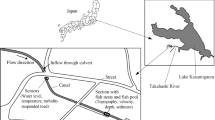Abstract
AT Marala barrage, two canals, i.e. Marala Ravi Link Canal (MRLC) and Upper Chenab Canal (UCC) off-take from left side of the River Chenab. MRLC has a very old history of experiencing sedimentation issues. Several attempts have been made to counterfoil or minimize this problem in the recent past. Two remarkable measures are the remodeling of MRLC in 2000–2001 (intervention-1) and the shifting of the confluence point of a heavily sediment-laden upstream tributary of the Chenab River by construction of a spur dike in 2004 (intervention-2). This paper investigates the effectiveness of these structural interventions as sedimentation control measures. The baseline period is selected from 1997 to 2000 and the impact is analyzed for two post-intervention time steps, i.e. evaluation period-1 ranging from 2001 to 2004 and evaluation period-2 from 2005 to 2011. Results obtained from double mass analysis revealed that sediment load increased by 33 and 8 % due to intervention-1, while decreased by 12 and 22 % due to intervention-2 in MRLC and UCC, respectively. The results suggest that monsoon floods are mainly responsible for sediment loading in the canals (66 % for UCC and 73 % for MRLC), supported by the finding that effective discharge (1900 m3 s−1) is almost twice the mean annual river discharge. The discharge classes between 900 and 2900 m3 s−1 are mainly responsible for major proportion (89 % in MRLC and 86 % in UCC) of the total sediment load over the 15-year study period. The intervention-1 could not minimize the sediment entry into the canals; rather it aggravated the situation. The intervention-2, however, proved a useful structural measure in this regard.






Similar content being viewed by others
References
Atkinson E (1994) Vortex-tube sediment extractors, I: trapping efficiency. J Hydraul Eng 120(10):1110–1125
Badruddin M (1996) Country profile: Pakistan. Internal report, International Water Management Institute (IWMI), Lahore, Pakistan
Bhatti MT, Latif M (2011) Assessment of water quality of a river using an indexing approach during the low-flow season. Irrig Drain 60:103–114
Charlton R (2008) Fundamentals of fluvial geomorphology. Routledge, New York
Chohan MA (1985) Remodelling Marala barrage and Link for silt control. In: Proceedings of Pakistan Engineering Congress Lahore, Pakistan Paper No. 484
Dietrich WE, Smith JD (1983) Influence of the point bar on the flow through curved channels. Water Resour Res 19:1173–1192
Dietrich WE, Smith JD (1984) Bed load transport in a river meander. Water Resour Res 20:1355–1380
Garg SK (2005) Irrigation engineering and hydraulic structures. Khanna, Delhi
Hickin EJ (1978) Mean flow structure in meanders of the Squamish River, British Columbia. Can J Earth Sci 15:1833–1849
Hooke JM (1997) Styles of channel change. In: Thorne C, Hey R, Newson M (eds) Applied fluvial geomorphology for river engineering and management. Wiley, Chichester
IRI (1988) Marala barrage-controlling silt entry into MR link: hydraulic model studies. Technical Report No. IRR-902/Hyd/MR link, Lahore, Pakistan
Markham AJ, Thorne CR (1992) Geomorphology of gravel bed River bends. In: Billi P, Hey RD, Thorne CR, Tacconi P (eds) Dynamics of grave-bed rivers. Wiley, Chichester
Melone AM (1988) Canals and waterways, sediment control. Field and general geology, encyclopedia of earth science. Springer science & business media
Munir S (2011) Role of sediment transport in operation and maintenance of supply and demand based irrigation canals; application to Machai Maira Branch Canals. PhD thesis, Wageningen University, Wageningen, The Netherlands
Rizvi SA, Latif M, Ahmed S (2012) Mapping spatial disparity of canal water distribution under irrigated cropping environment using satellite imageries. Int J Environ Sci Tech 9:441–452
Sarwar MK, Anjum MN, Mahmood S (2013) Impact of silt excluder on sediment management of an irrigation canal: a case study of D. G. Khan Canal, Pakistan. Arab J Sci Eng 38(12):73–84
Shakir AS, Khan NM (2009) Impact of structural interventions on sediment management of large canals: a case study of Marala barrage, Pakistan. Water Resour Manag 23:3149–3163
Tena A, Batalla RJ, Vericat D, López-tarazón JA (2011) Geomorphology suspended sediment dynamics in a large regulated river over a 10-year period (the lower Ebro, NE Iberian Peninsula). Geomorphology 125(1):73–84
World Bank (2005) Pakistan water resources assistance strategy. Water economy: running dry. Report No. 34081- PK, Agriculture and Rural Development Unit, South Asia Region, World Bank, Washington, DC
Yonesi AH, Omid HM, Hanghiabi HA (2008) A study of the effects of longitudinal arrangement of submerged vanes on sediment behavior near intake structures. J Hydraul Res 46(6):814–819
Acknowledgments
Muhammad Ashraf was financially supported by the Higher Education Commission (HEC) of Pakistan within the framework of Indigenous Scholarship Program. This financial support is gratefully acknowledged and appreciated. The authors acknowledge the support of the executive engineer at Marala barrage and Irrigation Department, Punjab, for providing discharge and sediment data.
Author information
Authors and Affiliations
Corresponding author
Rights and permissions
About this article
Cite this article
Ashraf, M., Bhatti, M.T., Shakir, A.S. et al. Sediment control interventions and river flow dynamics: impact on sediment entry into the large canals. Environ Earth Sci 74, 5465–5474 (2015). https://doi.org/10.1007/s12665-015-4604-3
Received:
Accepted:
Published:
Issue Date:
DOI: https://doi.org/10.1007/s12665-015-4604-3




